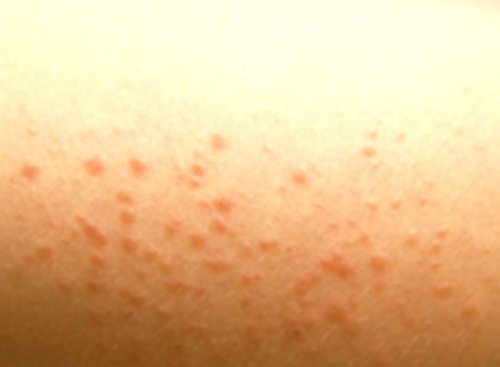Chlorine Rash
Swimming is a great form of exercise, especially for people with lung problems. However, swimming in a pool can sometimes cause allergy, especially if you have a sensitivity to chlorine.
Chlorine is a skin irritant. Can chlorine make your skin itch? Yes, especially if you have a sensitive skin. It causes drying of the skin, which makes it prone to irritation. It can also indirectly contribute to respiratory problems by irritating the respiratory tract. Prolonged exposure to swimming pools with high chlorine content puts you at risk for asthma and other respiratory illnesses. (2, 4, 6)
Swimming pools contain chlorine but usually in small amount. However, some swimming pools have high level of chlorine. The purpose of chlorine in the swimming pool is to disinfect it so that bacteria and other pathogens will be killed.
Some people don’t have any problems being exposed to pools with chlorine. However, some people develop chlorine allergy. They complain of chlorine rash and discomfort. A chlorine rash is also known as swimming pool rash because the rash appears after patients have been to a swimming pool. (1, 3, 4)
Chlorine Rash Pictures

Photo 1: A typical clinical manifestation of a chlorine rash.
Picture Source: doctordecides.com

Image 2: A severe form of chlorine rash wherein there is an obvious inflammation and reddish discoloration of the skin.
Photo Source: medmum.com

Photo 3: A severe form of chlorine rash affecting the abdomen and the upper torso.
Picture Source: medicalbite.com
Rash from chlorine : Symptoms
- Severe itching
- Noticeable small bumps all over the skin which could turn into patches after a few hours or days
- The patches turn red and the affected body parts swell
- A noticeable pain in the affected body parts
- The patient complains of watery, swollen, painful, and itchy eyes
- There is a scaling or crusting of the skin
- Difficulty/labored breathing and a feeling of chest tightness
- Coughing, especially at night time
- Sneezing and runny nose
- An abnormal sound during breathing (wheezing/whistling sound) (1, 5, 7)
What causes a chlorine rash?
As the name implies, chlorine is the primary causative factor for chlorine rash. What is a chlorine? It is a yellow-green dense gas used to kill bacteria. It is added in the swimming pool and public pools to get rid of bacteria and other pathogens.
However, too high chlorine level can cause skin irritation and other health problems. Those with chlorine intolerance are susceptible to rashes and respiratory-related problems. (8, 9)
Chlorine Rash Treatment
How to treat a chlorine rash? What you can do to get rid of rashes? How long does chlorine rash last? If you notice a rash after being exposed to chlorine, you should immediately wash the affected area with clean water. Chlorine rash remedies are vast. The treatment of choice depends on the factors that cause the rash. On a medical standpoint, the usual treatment modalities include the following:
- Cream/ointment – A prescription cream can help improve the condition of the rash, alleviates pain and inflammation, and relieves itching. However, for the cream to be effective it should be used as prescribed by the doctor. Strictly follow the usage instruction for you to get the best result. (10)
- Antibacterial soap – Keep the affected area of the skin clean by washing it with antibacterial soap. This is to prevent secondary infection, which could worsen the overall condition of the skin. It is important to keep the affected area of the skin clean and dry at all times. (2)
Home Remedies for Chlorine Rash
- Warm and cold compress – Chlorine rashes are itchy and at the same time painful. To alleviate the pain and relieves itching, a warm and cold compress should be done on the affected parts of the body.
- Starch bath – Trying to scratch the itch can increase the possibility of infection. To somehow lessen the itchy feeling, the patient should have a starch bath. Basically, it is a water with a corn starch mixture.
- Aloe Vera – The extracts of fresh Aloe Vera soothe itchiness. Apply the extracts directly on the affected part of the body several times a day. (1, 4, 5)
Prevention
Just because you are sensitive to chlorine does not necessarily mean that you can no longer swim in the swimming pool. You just need to find out how you can prevent chlorine rash. The following tips can help prevent the possibility of having a chlorine rash.
- When swimming in a public swimming pool, do not hesitate to ask the manager about the level of chemicals in the waters.
- After swimming, you should immediately remove your swimsuit so as to limit the skin contact with chlorine.
- Take a shower before and after swimming.
- If you have a private pool, you need to make sure you are going to put the right amount of chlorine in the water. It is important to keep the level of bacteria low but it is also important to take care of your skin. Too much chlorine in the water can cause skin irritation. The ideal chlorine level is between 1.0 – 3.0 ppm. (4, 6)
- When swimming in a public pool, you should first test the pH level of the water. You can try submerging a part of your feet and wait for a few minutes. If rashes didn’t appear, then it is an indicator that the water has a safe chlorine level.
- There are skin care products designed to prevent the development of chlorine rash. It is usually in the form of lotion. Apply the lotion before swimming. There are different brands to choose from and the prices vary depending on the brand.
- After swimming, you should apply vitamin C spray. This is to prevent skin irritation which can be caused by high level of chlorine in the water. (8)
- Make it a habit to rinse after swimming. Use antibacterial soap and clean your skin properly. It would also help if you are going to hit the sauna after swimming. This is to bring out the chlorine smell through sweating. (9)
Many people can stand a high level of chlorine in the water. However, if you have a sensitive skin you are most likely susceptible to chlorine rash and other forms of skin rashes. The skin is the first line of defense and so it is important to keep it clean and intact. Avoid rashes brought by high level of chlorine by following the above-mentioned recommendations.
References:
- http://acaai.org
- http://mddk.com
- http://doctordecides.com
- www.fastmed.com
- www.treatnheal.com
- http://health-benefits-of.net
- www.swimspray.com
- http://medicaltreasure.com
- www.livestrong.com
- www.healthy-skincare.com